Mission: To promote driving less so all may live more.
In 1965, Ralph Nader published Unsafe at Any Speed, the book that tackled the unsafe practices of the auto industry and launched the modern consumer protection movement. This is a short post that recognizes the merits of Nader’s efforts.

Recently on Nader’s radio broadcast, the 55th anniversary of its publication was recognized by his guest, Joan Claybrook, who, under the Carter administration, headed the National Highway Traffic Safety Administration. The show is entitled “How To Save 4.2 Million Lives”—that number being derived from the automobile-related fatality rate of 1965 compared to the current rate, taking into consideration the increased use of automobiles over time.[1]
While Person vs. Automobile argues that the self-propelled person remains threatened by automobile traffic, Nader argued that the automobile consumer remains threatened by the automobile industry. However, he devotes a chapter to the bumpers and fins on cars that effectively and stylishly smash and slice pedestrians with ease. Later in his career, his work promoted the creation of the U.S. Environmental Protection Agency and the passage of the Clean Air Act.[2]
Chapter 1 focused on shortcomings in the design of the Chevrolet Corvair. While that chapter was later disputed by several government-commissioned reports, it nevertheless hit a nerve with General Motors. In court it was proven that General Motors had tapped Nader’s phone and had sent women to attempt entrapping Nader sexually. He sued General Motors and was awarded $425,000 in 1970 (almost three million dollars in 2020). According to Wikipedia, “Former GM executive and Chevrolet’s general manager John DeLorean asserted in his book On a Clear Day You Can See General Motors (1979) that Nader’s criticisms were valid.”[3]
During Nader’s interview with Claybrook, they discussed various legislative and engineering advancements that could spare the lives of many pedestrians and bicyclists. One would be the development of the technology and the incorporation of “a performance rule that you cannot start the car if you’re over 0.08 alcohol.” Another enhancement (which echoes what I once heard a city bus driver utter) would be the automatic disabling of cell phones for all drivers:
Ralph Nader: If you had one comment to make on distracted driving, which is taking over 7,000 lives a year, it’s beginning to creep up to be equal with drunk driving, give us a brief summary of the situation there.
Joan Claybrook: Well, distracted driving is very related to use of cell phones in the car. And this issue has arisen because of that in recent years. And there needs to be technology that does not allow the use of the phone while you’re driving. And some phones now say, do not use if you’re driving, but then you say, “I’m not driving.” You press the little thing. I’m not driving, and then you can use it. So there needs to be much better technology. That’s the only way it’s going to happen, because people are too tempted to use their phones at all times. And there’s work going on on that. It’s not perfected yet, but that’s a huge priority because of the large number of lives involved.
Nader is now 86 and going strong. If he had done nothing more than publish Unsafe at Any Speed in 1965 when he was 31, that would have been a lifetime achievement. However, he has gone on to fight corporate crime on several levels, as well as to resist the dulling force of the duopoly in American politics, not to mention pursuing an ongoing crusade against “climate crisis, climate catastrophe, climate disruption, climate upheaval” or any other term that suggests the seriousness of the condition.[4]
Kudos.
____Footnotes____
[1] The interview with Claybrook takes up the first 20 minutes of the episode. See The Ralph Nader Radio Hour, which includes the audio and a transcript.
